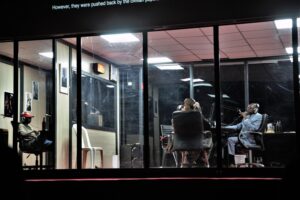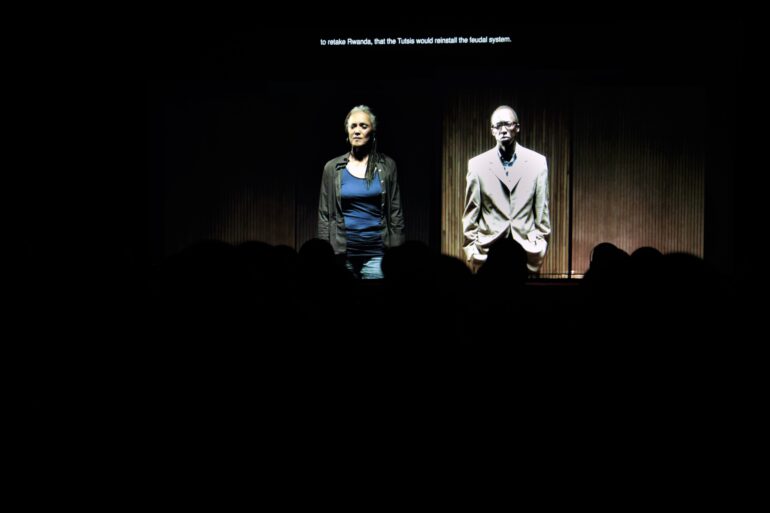The impact of media is widely recognized, with Radio still holding wider coverage. The contemplation of what would arise if only the media was wrongly used barely crosses most people’s minds. Hate speech, and Hate media may sound like new terms elsewhere, but not in Rwanda.
Hate Radio, a theatre production brings to life the impact media had in the orchestration of the 1994 Genocide against the Tutsi. Away from the escalation of events which mainly encompassed the brutal executions of the Tutsi during the 1994 Genocide, this production whose concept is created and directed by Swiss Milo Rau, while its Dramaturgy and production are by Jens Diethrich rather presents something unique.

Behind the genocide, fueling was hate media, from which Radio Télévision Libre des Mille Collines (RTLM), the then government-controlled media played a key role. Transforming the Kigali Convention Centre auditorium, where the production was hosted, first is the set whose stage is converted into a multi-purpose platform for delivery. The rectangular-shaped elevated stage initially serves as a screen on which images are projected as the whole auditorium remains dark. The play introduces us to four witnesses, survivors of the 1994
genocide against the Tutsi. These recount the times, from learning that the plane that carried President Juvenile Habyarimana had been shot down on April 6th, 1994, to how the brutal atrocities brewed up.
While some had foreseen the danger and escaped to exile, others did escape, but narrowly as executions had kicked off, and some recount having stared death in the eye, with one witnessing the gruesome slaughter of her entire family, while she was buried among dead bodies only to survive after being exhumed by the Rwanda Patriotic Front (RPF) Inkotanyi.
Amidst each testimony, mainly in French and Kinyarwanda languages, with English subtitles, a transition to the next survivor are songs, and sound effects reflective of back then. These paint the then-ancient radio broadcast segments by Radio Télévision Libre des Mille Collines.
The second scene of the theatre play introduces the audience to the Radio Télévision Libre des Mille Collines broadcast studios, where four radio personalities (three men and one lady) are at their seemingly normal work of presenting. But unlike the usual broadcast, the presenters who include Sebastien Foucault, Diogéne Ntarindwa as Kantano Hahimana, Bwanga Pilipili, and Eric Ngangare, hold a unique set and it is evident how these are under a unique influence.
Within the studio, as they present, we see a military man who is serving them drinks, and cigarettes. But their broadcast is an unusual one, for they are equally excited, chanting, and ranting over what is ongoing. These sensitize the public over the Tutsi whom they refer to as Inyenzi (Cockroaches) being targeted for destruction. But, at one point one may be drawn into the imagination of how influences do rush and are directed from numerous directions, by various forces. For instance, the presence of an armed military man in the studio just signals them, and only shapes them to the current command of the military regime calling for a massive wipe-out, bloodshed, a genocide.
The fact that they are also being intoxicated influences them more onto the regime’s leash, of being used. The broadcast offers no hope but rather fuels up militias while instilling fear into the would-be saviors. They report from only Kangura Newspaper, a Rwandan Newspaper which also stayed active during this turmoil.
Presenters further belittle, and insult any foreign media agency, and countries like America, which had roots in the country but weren’t being ‘cooperative’ towards the regime’s agenda of wiping out the ‘Inyenzi,’ as thought of entirely by the genocide extremists.
Having held its official grand Rwandan premiere recently in Kigali, the production brings to life the events that transpired through RTLM, which was used in spreading the propaganda that led to the brutal executions against the Tutsi minorities.
Orchestrated by the then leadership, the presenters’ chants, characterized by uttering threats targeting the Tutsi, the RPF Inkotanyi, and the United States troops too, RTLM birthed and nurtured an odd culture, which gradually led to a blood birth by the Hutu extremists.
Notable among these is Kantano, a role Ntarindwa takes on, depictive of the prominent outrageous personnel in strong support of the President Habyarimana regime, and the killings. Clad in a grey suit, he echoes the Hutu militias to report to ‘work,’ meaning to execute.
Sebastien Foucault, who takes on the role of French Journalist Georges Ruggiu, is seen reading international news updates between talks. From how he does his presentation, in a mockery way, it is evident how he too is a stronger propagandist and ally to the extremist’s regime.
Eric Ngagare’s role as the Station Deejay and prominent cheerleader towards the warmongering is seen active as he sips a beer. Alongside the newsy on-Air broadcast, he owns up his space as a Radio Jockey, emerging with a personality so consumed by the moment. He selects which tune will go with the war decree, as he enthusiastically accompanies it with words of affirmation, on how they own the victory.
The one-hour fifty minutes documentary theatre presentation was initially created in 2011. It held its initial premiere in Kigali and Europe in 2012, it has over time toured North and South America, Asia, and South Africa too, where it has been rendered definitive and unique.
The play is concluded, just similar to how it began, switching back to survivor’s tales as they each reveal how, and when they returned to normality in Rwanda, after the restoration of the country’s peace by the RPF government.
The production provides vivid proof of how the media can negatively be used as a hate tool in politics and the harm that can result.
“I worked on different elements within the play, where I allow myself to be possessed by the monster, who takes over since we are different,” Ntaridwa explains, “Presenting it in Rwanda is a bit delicate, and a whole different experience unlike elsewhere, but it is a fulfilling one for people learning of how media was used in influencing and impacting the worst part of history,” he adds.
Article By Andrew I. Kazibwe
End

